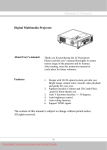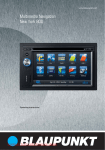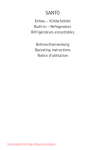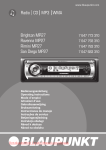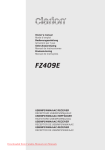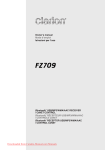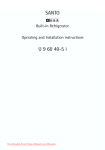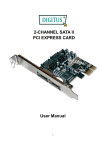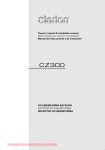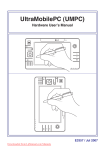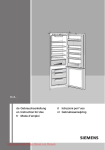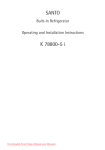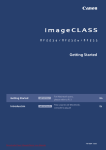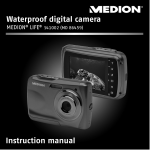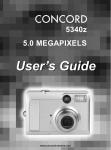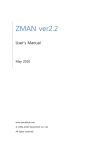Download Rovershot RS-5310Z User Guide Manual
Transcript
Table of contents 1 Getting Started Digital Zoom....................................17 Package Contents .............................1 4 Taking Pictures System Requirements .......................2 Windows ...........................................2 Macintosh..........................................2 Basic Still Image Shooting ..............18 Safety Information............................3 FCC Compliance and Advisory...........4 Camera Components .........................5 Front.................................................5 Rear..................................................5 Top ...................................................5 Side ..................................................6 Replaying an Image after Shooting Quickly .............................19 Setting the Image Quality and Resolution .......................................19 Using the Flash ...............................20 Setting the Red-eye Reduction Function ..........................................20 Selecting the Metering Mode ..........21 Using the Included Accessories ........6 Attaching the Wrist Strap....................6 Using the Soft Case............................6 Macro Mode.....................................21 Operating the Multi-controller ..........7 Shooting in Long Shutter Mode ......23 2 Preparing the Camera Installing the Batteries .....................8 Battery Status Indications...................8 Setting the Self-Timer.....................22 Adjusting the Exposure ---EV adjustment......................................23 Adjusting Color Tones ---Setting Installing an SD Card ........................9 To remove the SD card .......................9 the White Balance...........................24 Formatting Internal or SD Card Using the Photo Effect ....................25 Memory .............................................9 Movie Mode .....................................26 Turning the Power On / Off ............10 5 Replaying Photo & Video Clips Setting the Date and Time ..............11 Date Stamp .....................................11 Setting the Language......................12 Selecting Menus and Settings .........13 3 Basic Functions Setting the LCD Display Mode.........15 Shooting Mode................................. 15 Playback Mode................................. 15 Using the Scene Mode.....................24 Replaying Pictures ..........................27 Magnifying Images .........................27 Viewing Pictures in Thumbnail Mode ...............................................28 Erasing Files From Memory.............27 Erasing Images Individually ..............28 Erasing All Unprotected Images.........29 Protecting Photos and Video Information Displayed on the Clips ................................................29 LCD Monitor ....................................16 Shooting Mode................................. 16 Playback Mode................................. 16 Playing a Slide Show (Auto Play)....30 Using the Zoom Feature..................17 Downloaded From camera-usermanual.com Rovershot Manuals Copying Flash Memory Images to a Memory Card............................30 Setting USB Mode ........................... 30 9 Appendix 6 File Names & Printing Troubleshooting.............................. 48 About File and Folder Numbers ...... 31 Folder File Capacity...........................31 Specifications.................................. 49 File Number Reset .......................... 32 DPOF Print Settings ........................ 33 Selecting Images for Printing.............33 Printing still images with a PictBridge printer ........................... 34 Printing images............................... 34 Setting Print Size ............................ 35 PictBridge Custom Menu ................ 36 7 Making Connections Viewing Images on the TV.............. 37 Selcting the Video Out Signal Mode ............................................... 37 Downloading Images to a Computer ........................................ 38 Downloading Directly from an SD Card ................................................38 Connecting the Camera to a Computer with a USB Cable ..............39 Understanding Camera Memory and Storage .................................... 40 Internal Memory...............................40 Optional SD Memory Card .................40 DCF Protocol ....................................40 8 Installing Software Install the Software Driver............. 39 Installing Ulead Photo Explorer 8 SE Basic........................................ 42 Using the Ulead Photo Explorer 8 SE Basic........................................ 45 Installing Ulead VideoStudio 7 SE Basic........................................... 46 Installing Utilities ........................... 47 Downloaded From camera-usermanual.com Rovershot Manuals 1 Getting Started Package Contents Please contact your dealer immediately if any of the items below are missing or damaged. USB Cable Camera Video out Cable 2 AA Batteries Soft Case Strap User Manual Software Installation CD-ROM Quick Start Guide -1Downloaded From camera-usermanual.com Rovershot Manuals System Requirements Windows: PC with processor better than MMX Pentium 233 MHz Windows XP/2000/ME/98SE/98 Minimum 32 MB RAM USB port CD-ROM drive 800x600 pixels, 16-bit color display compatible monitor Macintosh: Power Mac G3 or later Mac OS 9.0, 9.1, 9.2 and OS X Minimum 64 MB RAM USB port CD-ROM drive 800x600 pixels, 16-bit color display compatible monitor Specifications are subject to change without prior notice. -2Downloaded From camera-usermanual.com Rovershot Manuals Safety Information Before using the camera, please ensure that you read and understand the safety precautions described below. Always ensure that the camera is operated correctly. Do not aim the camera directly into the sun or other intense light sources which could damage your eyesight. Do not try to open the case of the camera or attempt to modify this camera in any way. High-voltage internal components create the risk of electric shock when exposed. Maintenance and repairs should be carried out only by authorized service providers. Do not fire the flash too close to the eyes of animals or people, especially for young children. Eye damage may result. In particular, remain at least one meter away from infants when using flash. Keep the camera away from water and other liquids. Do not use the camera with wet hands. Never use the camera in the rain or snow. Moisture creates the danger of fire and electric shock. Keep the camera and its accessories out of the reach of children and animals to prevent accidents or damage to the camera. If you notice smoke or a strange odor coming from the camera, turn the power off immediately and unplug the AC adapter from the power outlet. Take the camera to the nearest authorized service center for repair. Never attempt to repair the camera on your own. Use only the recommended power accessories. Use of power sources not expressly recommended for this equipment may lead to overheating, distortion of the equipment, fire, electrical shock or other hazards. Disconnect the compact power adapter from both the camera and power outlet after recharging and when the camera is not in use to avoid fires and other hazards. The compact power adapter of the camera is designed for exclusive use with this camera. Do not use it with other products. There is a risk of fire and other hazards. -3Downloaded From camera-usermanual.com Rovershot Manuals FCC Compliance and Advisory This device complies with Part 15 of the FCC Rules. Operation is subject to the following two conditions: 1.) this device may not cause harmful interference, and 2.) this device must accept any interference received, including interference that may cause unsatisfactory operation. This equipment has been tested and found to comply with the limits for a Class B peripheral, pursuant to Part 15 of the FCC Rules. These limits are designed to provide reasonable protection against harmful interference in a residential installation. This equipment generates, uses, and can radiate radio frequency energy and, if not installed and used in accordance with the instructions, may cause harmful interference to radio communication. However, there is no guarantee that interference will not occur in a particular installation. If this equipment does cause harmful interference to radio or television reception, which can be determined by turning the equipment off and on, the user is encouraged to try to correct the interference by one or more of the following measures. Reorient or relocate the receiving antenna. Increase the separation between the equipment and receiver. Connect the equipment to an outlet on a circuit different from that to which the receiver is connected. Consult the dealer or an experienced radio/TV technician for help. Any changes or modifications not expressly approved by the party responsible for compliance could void the user’s authority to operate the equipment. When shielded interface cables have been provided with the product or when specified additional components or accessories have elsewhere been designated to be used with the installation of the product, they must be used in order to ensure compliance with FCC regulations. -4Downloaded From camera-usermanual.com Rovershot Manuals Camera Components Front Rear Shutter button Top -5Downloaded From camera-usermanual.com Rovershot Manuals DC IN terminal USB port Video out terminal Side Using the Included Accessories Attaching the Wrist Strap The illustration shows how to attach the wrist strap to your camera. Don’t swing the camera when carrying it by the wrist strap. Using the Soft Case Store the camera in the included soft case when not in use. Slide the camera in the case with the LCD screen facing down as illustrated. -6Downloaded From camera-usermanual.com Rovershot Manuals Operating the Multi-controller The multi-controller is used to select choices, images and menus on the LCD monitor and confirm the selection. Up button Right button Left button Down button Moving the cursor on the LCD monitor up and down. Press the Press the button. or to select a menu item on the LCD monitor. Moving the cursor on the LCD monitor left and right. Press the Press the button. or to select a menu item on the LCD monitor. Confirming a menu selection. Press the SET button. Press the button to close the menu window. -7Downloaded From camera-usermanual.com Rovershot Manuals 2 Preparing the Camera Installing the Batteries Insert two (2) AA-size alkaline batteries (included with the camera) 1. Be sure that the camera power is off. 2. Slide the SD card slot / battery cover and open the battery cover. 3. Insert the battery pack with the positive (+) and negative (-) poles matching the directions indicated inside the battery cover. 4. Slide the battery cover closed. Battery Status Indications The LCD monitor displays an icon or message to let you know when batteries are low or Depleted. Charge Level High Low Indicator When the indicator on the left side of the viewfinder is blinking green, the SD card is being written to, read, erased or transmitted to. Therefore, never turn off the camera or open the SD card slot/battery cover while this indicator is blinking green. -8Downloaded From camera-usermanual.com Rovershot Manuals Installing an SD Card 1. Turn off the camera. 2. Slide the SD card slot/battery cover in the direction of the arrow to open the cover. 3. Insert the SD card with the label facing up and the arrow pointing in. To remove the SD card 1. Turn off the camera. 2. Slide the SD card slot/battery cover in the direction of the arrow to open the cover. 3. Gently press on the edge of the SD card and release it. Pull the card out and close the slot/battery cover. Formatting Internal or SD Card Memory You should format a new SD card or one from which you wish to erase all images and other data. 1. Turn on the camera. 2. Press the 3. Press the button. arrow to select the Setup Menu. 4. Press the or arrow to select Format then press the button. -9Downloaded From camera-usermanual.com Rovershot Manuals 5. Press the and arrow to select Yes or No. 6. Press the SET button to confirm the selection. 1. Please note that formatting an SD card erases all the data it contains, including protected images and other file types. Please check the contents of the SD card before formatting it. 2. SD cards formatted in another camera, computer or peripheral device may not operate correctly. When that happens, reformat the SD card with this camera. Turning the Power On / Off Press the power button and hold it until the Power button LCD indicator begins flashing green. It takes about 1 second to power on the camera. To turn off the camera Press the power button to turn off the camera. 1. If camera power is turned off by the Auto Power Off feature, press the power button to turn it back. - 10Downloaded From camera-usermanual.com Rovershot Manuals Setting the Date and Time 1. Turn on the camera. 2. Press the 3. Press the button. arrow to select the Setup Menu. 4. Press the or arrow to select Date & Time then press the 5. Set the date and Time. 6. Press the and button. arrow to select a field to change. 7. Press the and arrow to set the values. 8. Press the SET button. 9. Press the button to close the menu window. Date Stamp Prints the image’s creation date on the image. 1. Press the 2. Press the button. or arrow to select Date Stamp then press the SET button. 3. Press the or to set Date Stamp on/off. 4. Press the SET button. 5. Press the button to close the menu window. -11Downloaded From camera-usermanual.com Rovershot Manuals Setting the Language 1. Press the 2. Press the button. arrow to select the Setup Menu. 3. Press the or arrow to select Language then press the SET button. 4. Press the or to select a Language. 5. Press the SET button to close the menu window. -12Downloaded From camera-usermanual.com Rovershot Manuals Selecting Menus and Settings Use the menus as shown below to operate the various shooting and replaying settings. 1. Press the 2. Press the button. or arrow to select the REC / Playback or the Setup Menu. 3. Press the or arrow to select a menu item then press the SET button. 4. Press the or to select the settings you wish to set then press the SET button. 5. Press the button to close the menu window. This chart shows the options for each menu settings. Menu Items Selectable with the MENU Button Menu Item Available Setting Scene Auto Resolution Quality Exposure Shooting Mode REC Menu +2/+1.7/+1.3/+1.0/+0.7/+0.3/0.0/0.3/-0.7/-1.0/-1.3/-1.7/-2.0 White Balance Metering Auto / Multi / Spot Effect Off Date Stamp On / Off Long Shutter Off / 1 sec / 2 sec / 4 sec / 8 sec -13Downloaded From camera-usermanual.com Rovershot Manuals Setup Menu Play Mode Playback Menu Movie Mode REC Menu Beep On / Off Power Off Off / 1 min / 3 min / 5 min Quick View No / Yes Date & Time Sets the date and time Language English/ Japanese / Traditional Chinese / Simplified Chinese / German / French / Spanish / Italian / Dutch / Portugese / Korean / Russian Format No / Yes File NO. Reset On / Off TV Out NTSC / PAL USB Computer / Printer Protect Single / Protect All / Unprotect All Delete All Single / All Slide Show Off / 5 sec / 10 sec Print Order Single / All / Reset Copy To Card No / Yes Exposure +2/+1.7/+1.3/+1.0/+0.7/+0.3/0.0/0.3/-0.7/-1.0/-1.3/-1.7/-2.0 White Balance Effect Off - 14Downloaded From camera-usermanual.com Rovershot Manuals 3 Basic Functions Setting the LCD Display Mode Pressing the DISP button switches the LCD screen display mode. Pressing the DISP button cycles the LCD screen to the next mode each time the button is pressed. Shooting Mode On (with Information)On (No Information) No LCD monitor display Playback Mode Display (Information) Simple Display (No Information) -15Downloaded From camera-usermanual.com Rovershot Manuals Information Displayed on the LCD Monitor The LCD monitor displays information in Shooting or Playback mode, such as the camera settings, remaining image capacity and shooting date. Shooting Mode Playback Mode -16Downloaded From camera-usermanual.com Rovershot Manuals Using the Zoom Feature The Zoom can be adjusted from 5.9 ~ 17.17 mm (35~103 mm when converted to 35 mm film format) Telephoto / Wide Angle Press W to zoom out for a wide angle shot. W Press T to zoom in for a telephoto shot. T Digital Zoom When the LCD monitor is on, you can digitally zoom in on a subject. Images can be zoomed up to 4 times. Press T to zoom in. The lens will zoom to the maximum optical telephoto setting and stop. Release the lever and press it toward again to further zoom the image digitally. The zoom indicator shows the current approximate zoom factor. -17Downloaded From camera-usermanual.com Rovershot Manuals 4 Taking Pictures Basic Still Image Shooting In this mode, all you have to do is press the shutter button and let the camera do everything else. 1. Set the camera mode switch to 2. Aim the camera at the subject. 3. Use the zoom level to achieve the desired composition. 4. Press the shutter button down halfway. . When the camera has finished adjusting its settings, the auto focus indicator will appear. 5. Press the shutter button all the way. 1. Please note that camera shake becomes a factor at low shutter speeds. If the camera shake warning appears on the LCD monitor, secure the camera to a tripod before shooting. 2. When the shutter button is pressed half way down, check the exposure value that appears on the LCD monitor to make sure it is appropriate for the current light conditions. 3. The green auto focus indicator appears on the LCD monitor when the camera has successfully locked the exposure, white balance, and focus. -18Downloaded From camera-usermanual.com Rovershot Manuals Replaying an Image after Shooting Quickly The quick playback function is available in each shooting mode. 1. Press to view the captured photo or video clip. 2. To delete the file, press . Press to select YES or NO, press SET and to confirm the choice. 3. Press mode. again, return to shooting Setting the Image Quality and Resolution You can change the image quality and resolution settings to suit the purpose of the image you are about to shoot. 1. Press the 2. Press the or REC Menu. Press the or arrow to select Resolution or Quality then press the SET button. Press the or to select the settings you wish to set then press the SET button. Press the button to close the menu window. 3. 4. 5. button. arrow to select the (Large) Resolution 2592¯1944 Purpose Print large prints (Medium 1) 2304¯1728 Print on small size paper (Medium 2) 1600¯1200 Send images by e-mail (Small) 640¯480 Shoot more images -19Downloaded From camera-usermanual.com Rovershot Manuals Image Quality Fine (5¯ compression rate) Purpose Shoot fine quality images Normal (8¯ compression rate) Shoot normal quality images Economy (12¯ compression rate) Shoot more images Using the Flash Use the flash according to the guidelines below Auto Force On The flash fires automatically as required by the lighting level. The flash fires automatically as required by the lighting level, and the flash pre-strobes before shooting to reduce red-eye phenomenon. The flash always fires. Force Off The flash does not fire. Red-eye reduction, Auto 1. 3. Press the SET button to switch between flash modes. The selected flash mode appears on the LCD monitor. You can switch between settings by 4. pressing the SET button. Shoot the image. 2. Setting the Red-eye Reduction Function The Red-eye reduction function fires when the flash is used in dark areas. This prevents light from reflecting back from the eyes and making them appear red. When shooting with the red-eye reduction function, the subjects must look right at the flash for this mode to be effective. Try asking them to look directly at the flash. Even better results can be obtained by shooting with the lens set to a wide angle, by increasing the lighting indoor settings, or by approaching closer to the subject. -20Downloaded From camera-usermanual.com Rovershot Manuals Selecting the Metering Mode This function enables you to select the metering mode to suit the shooting conditions and purpose. Multi-pattern metering The image is divided into multiple regions and metering is performed for each region. The camera judges the subject position and background brightness, and determines a wellbalanced exposure. Spot metering Meters the spot AF point corresponding to the AF frame. 1. Press the 2. Press the or REC Menu. Press the or arrow to select Metering then press the SET button. Press the or to select the settings you wish to set then press the SET button. Press the button to close the menu window. 3. 4. 5. button. arrow to select the Macro Mode Use the macro mode to shoot close-up of subjects in the range of 10 cm at the wide angle end and 50 cm at the telephoto end. 1. Press the DISPLAY button to turn the LCD monitor on. 2. 3. 4. Press the button. The icon appears on the LCD monitor. Shoot the image. -21Downloaded From camera-usermanual.com Rovershot Manuals 1. Distances referred to measure the distance between the camera lens surface and the subject. 2. Any flash setting can be used in macro mode. 3. Always use the LCD monitor to compose images in macro mode. Shooting with the optical viewfinder is possible, however, the parallax phenomenon may cause images composed with the optical viewfinder to be off-center. Setting the Self-Timer You can take pictures with the self-timer in any shooting mode. Use the self-timer to set a delay from the time the shutter button is pressed to the time the image is shot. 1. 3. Press the button to switch between Drive modes. The selected drive mode appears on the LCD monitor. You can switch between settings by 4. pressing the button. Shoot the image. 2. The self-timer lamp starts blinking after the shutter button is pressed all the way. The image will be shot after approximately 10 seconds. The self-timer blinking gets faster two seconds before the shutter activates. -22Downloaded From camera-usermanual.com Rovershot Manuals Shooting in Long Shutter Mode You can set the shutter speed to a slow setting to make dark subjects appear brighter. 1. 2. 3. 4. 5. Press the button. Press the or arrow to select the REC Menu. Press the or arrow to select Long Shutter then press the SET button. Press the or to select the settings you wish to set then press the SET button. Press the button to close the menu window. Please note that camera shake becomes a factor at low shutter speeds. If the camera shake warning appears on the LCD monitor, secure the camera to a tripod before shooting. Available Shutter Speeds The following shutter speeds are available: 1 sec, 2 sec, 4 sec, 8 sec Adjusting the Exposure ---EV adjustment Adjust the exposure compensation setting to compensate for certain light conditions including: backlighting, indirect indoor lighting, and dark backgrounds. 1. 2. 3. 4. button. Press the In the camera menu, press the or arrow to select Exposure then press the SET button.. Press the and to set the exposure compensation value. Available settings are:-2.0, -1.7, -1.3, -1.0, -0.7, -0.3, 0.0, +0.3, +0.7, +1.0, +1.3, +1.7, +2.0 then press the SET button. Shoot the image. -23Downloaded From camera-usermanual.com Rovershot Manuals Adjusting Color Tones ---Setting the White Balance When the white balance mode is set to match the light source, the camera reproduces colors more accurately. Auto Settings are automatically set by the camera Day light For recording outdoors on a bright day Shade For recording under overcast, shady or twilight skies Tungsten For recording under tungsten lighting Fluorescent For recording under fluorescent lighting 1. Press the button. 2. In the camera menu, press the or arrow to select White Balance then press the SET button. 3. Press the and to set the white balance value then press the SET button. Using the Scene Mode Selecting one of the 4 scenes automatically sets up the camera for recording a similar type of image. 1. 2. 3. 4. Press the button. Press the or arrow to select the REC Menu. Press the or arrow to select Scene then press the SET button. Press the or to select the settings you wish to set then press the SET button. -24Downloaded From camera-usermanual.com Rovershot Manuals 1. You can change the camera settings that are made when you select a scene. Note, however, that the scene settings revert to their defaults when you select another scene, change the recording mode. Using the Photo Effect An image can be recorded in a different Photo Effect Mode. Sepia Records images in sepia tones. Black & White Records images in black & white. Emphasizes the contrast and color saturation to record in bold colors. Press the button. Set Scene to “Auto” mode. Press the or arrow to select Effect then press the SET button. Press the or to select the settings you wish to set then press the SET button. Vivid 1. 2. 3. 4. -25Downloaded From camera-usermanual.com Rovershot Manuals Movie Mode The digital camera can shoot movie clips with audio. 1. 2. 3. 4. 5. 6. Set the camera mode switch to . Press the button to movie mode. The LCD monitor displays the maximum recording time. Press the shutter button all the way Press the shutter button all the way to stop recording the movie. The camera stops recording automatically when the memory capacity has been reached. Be careful not to touch the microphone while shooting. 1. The resolution is set to 320×240 pixels. Video resolution cannot be changed. 2. If the indicator on the left side of the viewfinder blinks green after a shot, this indicates that the movie is being written to the SD card. You cannot shoot again until it stops blinking. 3. White balance is set and locked to the settings of the first frame. -26Downloaded From camera-usermanual.com Rovershot Manuals 5 Replaying Photo & Video Clips Replaying Pictures You can view the recorded images and video clips on the LCD monitor. Set the camera mode switch to . The last recorded image or video clip appears on the LCD monitor. Use to move to the previous image and to move to the next image. Set the camera mode switch to , return to shooting mode. Press the DISP button to show the data for the displayed image. Press the button to quickly delete the displayed image. Magnifying Images Images can be magnified up from 1 times to 8 times. 1. 2. 3. 4. mode. In the PLAY Press T to magnify the image. Press the , , or arrows to move the magnified area around the image. Press W to zoom out to the original fullsized image. -27- Downloaded From camera-usermanual.com Rovershot Manuals The zoom factor is shown Viewing Pictures in Thumbnail Mode The The 1. 2. 3. 4. 5. 6. Thumbnail mode allows you to view up to nine images at a time on the LCD monitor. playback function is available in each shooting mode. In the PLAY mode. The last captured image appears on the LCD monitor. Press the wide angle W button to view thumbnail images. The selected image is highlighted. Press the , , or to select an image. Press the telephoto T button to display the selected image in full screen size. Erasing Files From Memory Erase files that you don’t want to keep to make more memory space available. You can erase individual files or all files when the camera is in playback mode. Erasing Images Individually 1. 2. 3. 4. In the PLAY mode. The last recorded image or video clip appears on the LCD monitor. Use to move to the previous image and to move to the next image. To delete the file, press . Press and to select YES or NO, press SET to confirm the choice. Please note that erased images cannot be recovered. Exercise caution before erasing a file. -28Downloaded From camera-usermanual.com Rovershot Manuals Erasing All Unprotected Images 1. 2. 3. 4. 5. 6. In the PLAY mode. The last recorded image or video clip appears on the LCD monitor. Press the button. Press the arrow to select Delete ALL. Press and to select Single or All, press and then select Yes or No, then press the SET button to confirm the choice. Press the button to close the menu window. Protecting Photos and Video Clips You can protect important images from accidental erasure. 1. 2. 3. 5. 4. 5. In the PLAY mode. The last recorded image or video clip appears on the LCD monitor. button. Press the Press the arrow to select Protect then press the SET button. Press and to select Single or All, press and then select Yes or No, then press the SET button to confirm the choice. Press the button to close the menu window. -29Downloaded From camera-usermanual.com Rovershot Manuals Playing a Slide Show (Auto Play) In slide show mode, all images can be displayed one-by-one in an automated slide show. 1. 2. 3. 4. mode. In the PLAY Press button. Press the arrow to select SLIDE SHOW then press the SET button. Press the or to select OFF, 5 sec, 10 sec and then press SET. The slide show begins automatically, starting from the current display image. 5. Press SET button to stop the slide show. Copying Flash Memory Images to a Memory Card The camera allows you to copy all files that are stored in the camera’s internal memory to an installed SD memory card. 1. 2. 3. 4. 5. In the PLAY mode. Press the button. Press the arrow to select Copy To Card then press the SET button. Press or to select YES or NO, press SET to confirm the choice. Press the button to close the menu window. Setting USB Mode You can set USB mode to connect the camera with a printer or computer. 1. 2. 3. 4. 5. button. Press the Press the arrow to select the Setup Menu. Press the or arrow to select USB then press the SET button. Press the or to select computer or printer. Press the SET button to close the menu window. -30- Downloaded From camera-usermanual.com Rovershot Manuals 6 File Names & Printing About File and Folder Numbers Images or video clips are assigned file numbers from 0001 to 9999, and folders are assigned folder numbers from 100 to 999 9998 9999 9998 9999 9998 9999 998 9998 9999 999 Folder File Capacity Each folder usually contains up to 9999 images. If a photo is taken when the folder with highest folder number contains a picture file number equal to or greater than 9999, the camera creates a new folder by adding one to the current folder number. For example, if the current folder is “100DICAM” the new folder is named “101DICAM.” If the highest folder number is 999 and the highest file number exceeds 9999, the camera will display the warning message “Folder Can Not Be Created.” If “Folder Can Not Be Created” appears, follow one of the two methods below: 1. Format the memory. The folder number and file number are initialized and renumbered from 100 and 0001 respectively. 2. Turn on File Number Reset in the camera menu and plug in a new memory card. -31Downloaded From camera-usermanual.com Rovershot Manuals File Number Reset Use File Number Reset if the camera experiences a “Folder Can Not Be Created” error or if you want to restart numbering, for example, after erasing all files. The file numbers are reset to the start (0001) each time a new SD card is On inserted. New images recorded on SD cards with existing files are assigned the next available number. The file number of the last image to be shot is memorized so that images Off recorded to a new SD card start from the next number. 1. Press the 2. Press the button. or arrow to select the REC Menu. 3. Press the or arrow to select File NO. Reset then press the SET button. 4. Press the or to select the settings you wish to set then press the SET button. 1. Setting the File No. Reset to OFF is useful for avoiding file name duplication when images are downloaded to a computer. 2. If the memory card is formatted, the folder number and the file number are initialized and the count starts from 100 and 0001. If the file Number Rest is set to OFF, the numbering starts after format with the last file and folder number stored in the camera. -32Downloaded From camera-usermanual.com Rovershot Manuals DPOF Print Settings The Digital Print Order Format (DPOF) setting allows you to select images on an SD card for printing and specify the number of print copies in advance using the camera. This is extremely convenient for sending the images to a photo developing service or for printing on a direct print function compatible printer. Selecting Images for Printing In play mode. 1. Press button. 2. In the Playback menu, press the or arrow to select Print Order. 3. Press SET to enter the PRINT setting menu. 4. Press the or arrow to select Single, All, Reset then press the SET button. 5. Press the or to set the number of copies (up to 999), then press to confirm the setting. 6. Press the or to set date on/off, then press SET button to confirm the setting. 7. Press the button to close the menu window. -33Downloaded From camera-usermanual.com Rovershot Manuals Printing still images with a PictBridge printer You can easily print images shot with your camera without using a computer by using a PictBridge-compliant printer. 1. Turn on the camera and the printer. 2. Set the USB mode to connect the camera with a printer. (P.30) 3. Connect the supplied USB interface cable to the printer’s USB port and the camera’s DIGITAL terminal. Printing images The PictBridge menu will be launch automatically when connecting the camera to a printer that supports PictBridge. 1. Press the or arrow to select Image. Press SET to enter the setting menu. 2. Press the or arrow to select Single, All then press the 3. Press the or button. to set the number of copies (up to 30), then press SET to confirm the setting. 4. Press the or then press the 5. Press the or arrow to select Print button. arrow to select Custom then press the button. -34Downloaded From camera-usermanual.com Rovershot Manuals 6. Press the or arrow to select Start then press the SET button. 7. The images is printed. Setting Print Size 1. In PictBridge menu. 2. Press the or Custom. Press arrow to select to enter the setting menu. 3. Press the or then press the 4. Press the or arrow to select Size button. to set the size of print, then press SET to confirm the setting. 1. The Printer’s options for the style category will differ slightly for different printers. -35Downloaded From camera-usermanual.com Rovershot Manuals PictBridge Custom Menu Item Menu Screen Size Type Layout Quality Date Settings Content • • • • • • • Au to Pos tc ard 4 × 6 8 × 10 A6 A4 B5 • • • • Auto Plain Photo Fast • • • • • • • • • • • • Auto 1 2 4 6 8 Index Full Auto Draft Normal Fine • • • Auto On Off • • • Auto On Off File -36Downloaded From camera-usermanual.com Rovershot Manuals 7 Making Connections Viewing Images on the TV Images displayed on the camera’s LCD screen can also be displayed on a television screen. A B 1. Plug the included video cable into the camera TV Out port (A). Plug the other end into the TV set Video port (B). 2. Set the TV input signal to Video In. Refer to the documentation included with your TV for more information. 3. Everything that would normally appear on the camera’s LCD screen, such as photo and video clip playback, slide shows, and image or video capture, appears on the TV. Selcting the Video Out Signal Mode The digital camera supports both NTSC (used in U.S.A., Japan, and other countries) and PAL (used in Europe and other areas) video signal systems. See TV Out Settings. section for information on setting the camera’s video system to match your region. - 37Downloaded From camera-usermanual.com Rovershot Manuals Downloading Images to a Computer Download images taken with the camera to a computer in one of the following ways: 1. Directly from the SD card. 2. Connect the camera to a computer with the USB cable. You must install the software and USB driver bundled on the Software Installation CD-ROM before connecting the camera to the computer. Downloading Directly from an SD Card 1. Eject the SD card from the camera, and insert it into an SD card reader connected to the computer. Note: If you are using a PC card reader, first insert the SD card into a PC card reader adapter (optional), and then insert the PC card adapter into the computer’s PC card slot. 2. Double-click the icon of the drive with the SD card. 3. Copy images from the card into a folder of your choice on the hard disk. - 38Downloaded From camera-usermanual.com Rovershot Manuals Connecting the Camera to a Computer with a USB Cable Note for Win 98/98 SE users: You must install the software and USB driver bundled on the Digital Camera software installation CD-ROM before connecting the camera to the computer. Connect the supplied USB interface cable to the computer’s USB port and the camera’s DIGITAL terminal. 錯誤! 1. You do not need to turn off the computer or camera when making this connection. 2. Please refer to your computer manual for information regarding the location of the USB port. The LCD monitor turns off when the connection to the computer has been successfully completed. 錯誤! 1. The camera will turn off automatically if the USB cable is disconnected. 2. Use an optional AC power adapter when connected to a computer to save battery power. 3. Windows 98/98SE user: If this is the first time the camera has been connected to the computer, Windows detects the camera as an “Unknown device” and automatically completes the required software installation. - 39Downloaded From camera-usermanual.com Rovershot Manuals Open My Computer or Windows Explorer. A “internal” appears in the drive list. Double-click the “internal” icon to view its contents. Files stored on camera are located in the folder named “DCIM” Understanding Camera Memory and Storage Internal Memory The digital camera is equipped with internal memory. If an SD card is not installed in the camera, all photos recorded by the camera will be stored in the internal memory. If an SD card is installed, photos and video clips are stored on the SD card. Optional SD Memory Card Photos, video clips, and other information recorded by the camera are stored on the SD card using the Design Rule for Camera File System (DCF) protocol. The DCF protocol is designed to accommodate file and data exchange between digital cameras and other devices. DCF Protocol The DCF protocol defines the format for image file data as well as the directory for the memory card. Photos that are taken by a DCF camera can be viewed on DCF-compatible cameras from other manufacturers. - 40Downloaded From camera-usermanual.com Rovershot Manuals 8 Installing Software Install the Software Driver You must install the camera software drivers if your operating system is Windows 98 or Windows 98 SE. Once the USB driver is installed, you do not need to install the USB driver again. 1. Start up your computer, and insert the software installation CD-ROM into the CD-ROM drive. 2. The model selection screen appears, If it does not appear, double-click My Computer and find the CD-ROM drive, then double-click the AutoRun. 3. Click Drivers on the model selection screen. Choose a language from the menu and click OK. The “InstallShield Wizard” screen appears. 4. Click Next. The USB driver installation starts. When the installation is completed, the screen informs you of completion. 5. Click “Yes, I want to restart my computer now” then click “Finish” Your computer restarts. Then, you can establish USB connection. - 41Downloaded From camera-usermanual.com Rovershot Manuals Installing Ulead Photo Explorer 8 SE Basic Ulead Photo Explorer 8 SE Basic is a photo editing application that is included for free in the software installation CD-ROM. You must use Windows XP/ME/2000/98SE on your computer to use this software. 1. Start up your computer, and insert the software installation CD-ROM into the CD-ROM drive. 2. The model selection screen appears, If it does not appear, double-click My Computer and find the CD-ROM drive, then double-click the AutoRun. 3. Click Ulead Photo Explorer 8 SE Basic on the model selection screen. Choose a language from the menu and click OK. Follow the on-screen instructions to install the software. - 42Downloaded From camera-usermanual.com Rovershot Manuals 4. A welcome window appears. Click Next to continue with the installation. 5. The Software License Agreement window appears. To accept the license, click Yes to continue. If you disagree with the terms of the license, click No to exit the installation program. 6. Select a destination folder in which the software will be installed. For most users, C:\Program files\ is the most appropriate choice. - 43Downloaded From camera-usermanual.com Rovershot Manuals 7. Click Next to begin copying files from the CD-ROM to the computer hard drive. 8. The TV System window appears. Select a country or video standard, then click Next to continue. 9. The Setup Options window appears. Click Next. - 44Downloaded From camera-usermanual.com Rovershot Manuals 10. The File association window appears. Select “Associate file formats with Ulead Instant Viewer” to set file associations. Click Next to continue. 11. When installation is completed, Click Finish to quit the InstallShield Wizard. Using the Ulead Photo Explorer 8 SE Basic Photo Explorer is a handy Web-enabled program for quickly viewing any multimedia file (such as image, animated GIF, video, or sound) in your computer. Operating very much like the Windows Explorer, Photo Explorer displays all your folders and files in a tree-like structure. Selecting a folder from this tree structure displays the image and graphics files in visual thumbnails. This provides the advantage of finding images visually rather than remembering file names when you want to open, delete, move, or copy files. You can take advantage of drag-and-drop technology when you want to insert a file into another application. Refer to the application help documentation for information on using the software. - 45Downloaded From camera-usermanual.com Rovershot Manuals To start this program, click Start > Program > Ulead Photo Explorer 8 SE Basic Installing Ulead VideoStudio 7 SE Basic Ulead VideoStudio is a consumer video editing software that lets users quickly and easily produce their own home videos complete with attractive titles, video filters, transitions, and sound. Unlike other software, Ulead VideoStudio features an intuitive step-based interface that helps users get started right away. Once you have completed your video projects, you can share them on tape, e-mail, the Web or burn your own high-quality VCDs. 1. Click Ulead VideoStudio 7 SE Basic on the model selection screen. Choose a language from the menu and click OK. 2. Follow the on-screen instructions to install the software. - 46Downloaded From camera-usermanual.com Rovershot Manuals Installing Utilities The utilities include QuickTime, Indeo, Windows media format, Acrobat reader and Microsoft DirectX software, which is required to play the recorded movie (mov file, asf file, Indeo format file or Windows media video) and read the PDF documents on your computer. 1. Click Utilities on the model selection screen. 2. Follow the on-screen instructions to install the software. - 47Downloaded From camera-usermanual.com Rovershot Manuals 9 Appendix Troubleshooting Problem Cause Solution Battery is inserted in the wrong direction Reload battery in the correct direction. Batteries are dead Replace or recharge batteries The battery compartment door is open Make sure the battery compartment door is securely closed. The flash is charging Wait for the flash to charge. Memory is full Insert a new SD card SD card is not formatted correctly The card may be defective, use a new card. Maximum file number is exceeded Turn “File No. Reset” on, then format the card or insert a new card. The flash is charging Wait for the flash to charge. Memory is full Insert an new SD card Flash is set to OFF Set the flash to any mode except off. The camera was moving when the image was captured Hold the camera shooting picture. The subject was beyond the range within which the camera can focus Turn the Macro mode on if the subject is within 10 cm (zoomed out) or 50 cm (zoom in) / don’t use Macro mode when shooting distant subjects. Image is not displayed on the LCD monitor An SD Card with non-DCIF images (recorded with another camera) is loaded This camera cannot display non-DCIF images. Recorded images are not saved in memory The camera was turned off/powered down before the image was stored in memory If the Battery Low indicator appears on the LCD monitor, replace the battery immediately. Cannot transfer images to a computer after connecting the USB cable USB driver is not installed Install the USB driver before you connect the camera to a computer / turn the camera on. Power does not turn on The camera does not take pictures Image is not recorded when the shutter button is pressed The flash doesn’t fire Image is blurry or out of focus - 48Downloaded From camera-usermanual.com Rovershot Manuals steady when Specifications Sensor Lens View Finder Color LCD Display Focus Range ISO/ASA Sensitivity Still Image Resolution Video Resolution Still Image quality Exposure Control Exposure Compensation Auto Lock Exposure Meter Shutter 5.36 Mega Pixels CCD Size : 1/2.5 inch Focal length:f5.9~f17.17mm, 3× zoom lens Optical with real image 1.6” TFT LCD Panel Normal Mode:50cm~infinity, Macro Mode:10cm~50cm 70 2592 × 1944, 2304 × 1728, 1600 × 1200, 640 × 480, MPEG4 , (320 × 240, 30 fps), with audio Fine : 5 × compression rate Normal : 8 × compression rate Economy : 12 × compression rate Auto & Manual -2EV to +2EV in 1/3 step. AE is locked by S1 Auto, Multi, Spot Mechanical shutter, 1/2000 ~ 8 sec. with CCD variable electronic shutter Optical Zoom 3 × , continues Digital Zoom Preview mode : 4 ×, continuous Playback mode : 8 ×, scrollable Image File Format White Balance Photo Effect Start-up Time Picture Storage Still : EXIF 2.2 compatible format (JPEG compression) DCF compatible. Support DPOF, PIM II, Pictbridge Auto, Day light, Shade, tungsten, fluorescent No effect, B&W effect, Sepia, Vivid Less than 4 sec. Internal : 16 MB embedded flash memory External : SD memory card up to 512 MB Microphone Built-in Sound Feedback Speaker Communication Interface Self-Timer USB 1.1, Compliance with USB2.0 10 sec. with beep sound Playback Mode Single / 9 thumbnails / slide show Power Supply Battery : AA Size x 2 DC input : 3.3V 2.0A DC adapter Dimensions Weight Ambient temperature 92.1 × 62.1 ×35.5 (mm) Camera body w/o batteries: 147 g Operating : -5 to 40 ˚ C Storage : -20 to 60 ˚ C - 49Downloaded From camera-usermanual.com Rovershot Manuals



















































